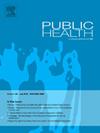Early childhood risk factors for unhealthy weight control behaviour in adolescents
IF 3.2
3区 医学
Q1 PUBLIC, ENVIRONMENTAL & OCCUPATIONAL HEALTH
引用次数: 0
Abstract
Objectives
To assess the childhood risk and protective factors that are associated with unhealthy weight control behaviours (UWCB) in adolescence.
Study design
Longitudinal study.
Methods
The Longitudinal Study of Australian Children Kindergarten cohort waves 1, collected in 2004 (4–5 years, N = 4985), and wave 6 collected in 2014 (14–15 years) was used. Predictor variables at wave 1 included gender, country of birth, study child weight category (from BMI z score), social development score, screen time, childhood injury, primary carer mental illness status, teacher conflict scale, stressful life events, socioeconomic position and an interaction term, study child weight category (from BMI z score) and stressful life events. UWCBs were measured at wave 6. Multivariable logistic modelling using odds ratio was used to explore the predictors of UWCB at wave 6.
Results
Statistically significant risk factors at age 4–5 years for UWCB at age 14–15 years included female sex (OR = 1.81, 95 % CI 1.28, 2.55), obese weight compared to healthy weight (OR = 3.72, 95 % CI 1.56, 8.84) and study child injured more than once (OR = 2.08, 95 % CI 1.13, 3.82). The statistically significant protective factor included a one-point increase in socioeconomic position (OR = 0.76, 95 % CI 0.65, 0.90) and underweight compared to healthy weight (OR = 0.15, 95 % CI 0.03, 0.74). However, underweight individuals who experienced stressful life events had an increased risk of UWCB (OR = 1.50, 95 % CI 1.01, 2.22).
Conclusions
This study has identified the childhood risk factors for adolescent UWCB. Risk factors that may have potential to be reduced include childhood injury and stressful life events, with the analysis identifying that underweight individuals within these groups are at a heightened risk. Therefore, development of interventions targeting these modifiable stressful events in childhood need to be established and evaluated.
青少年不健康体重控制行为的幼儿期危险因素
目的探讨青少年期不健康体重控制行为(UWCB)的相关危险因素及保护因素。研究设计:纵向研究。方法采用2004年收集的澳大利亚儿童幼儿园队列第1波(4-5岁,N = 4985)和2014年收集的第6波(14-15岁)的纵向研究。第一波的预测变量包括性别、出生国家、研究儿童体重类别(来自BMI z分数)、社会发展分数、屏幕时间、童年伤害、主要照顾者精神疾病状况、教师冲突量表、压力生活事件、社会经济地位和互动术语、研究儿童体重类别(来自BMI z分数)和压力生活事件。uwcb在波6处测量。使用比值比的多变量logistic模型来探索第6波UWCB的预测因子。结果4-5岁14-15岁UWCB的危险因素有统计学意义,包括女性(OR = 1.81, 95% CI 1.28, 2.55)、与健康体重相比的肥胖体重(OR = 3.72, 95% CI 1.56, 8.84)和研究儿童不止一次受伤(OR = 2.08, 95% CI 1.13, 3.82)。具有统计学意义的保护因素包括社会经济地位增加1个点(OR = 0.76, 95% CI 0.65, 0.90)和体重低于健康体重(OR = 0.15, 95% CI 0.03, 0.74)。然而,体重过轻且经历过压力生活事件的个体UWCB的风险增加(OR = 1.50, 95% CI 1.01, 2.22)。结论本研究明确了青少年UWCB的儿童危险因素。有可能减少的风险因素包括童年伤害和生活压力事件,分析表明,这些群体中体重过轻的人风险更高。因此,需要建立和评估针对儿童时期这些可改变的压力事件的干预措施。
本文章由计算机程序翻译,如有差异,请以英文原文为准。
求助全文
约1分钟内获得全文
求助全文
来源期刊

Public Health
医学-公共卫生、环境卫生与职业卫生
CiteScore
7.60
自引率
0.00%
发文量
280
审稿时长
37 days
期刊介绍:
Public Health is an international, multidisciplinary peer-reviewed journal. It publishes original papers, reviews and short reports on all aspects of the science, philosophy, and practice of public health.
 求助内容:
求助内容: 应助结果提醒方式:
应助结果提醒方式:


